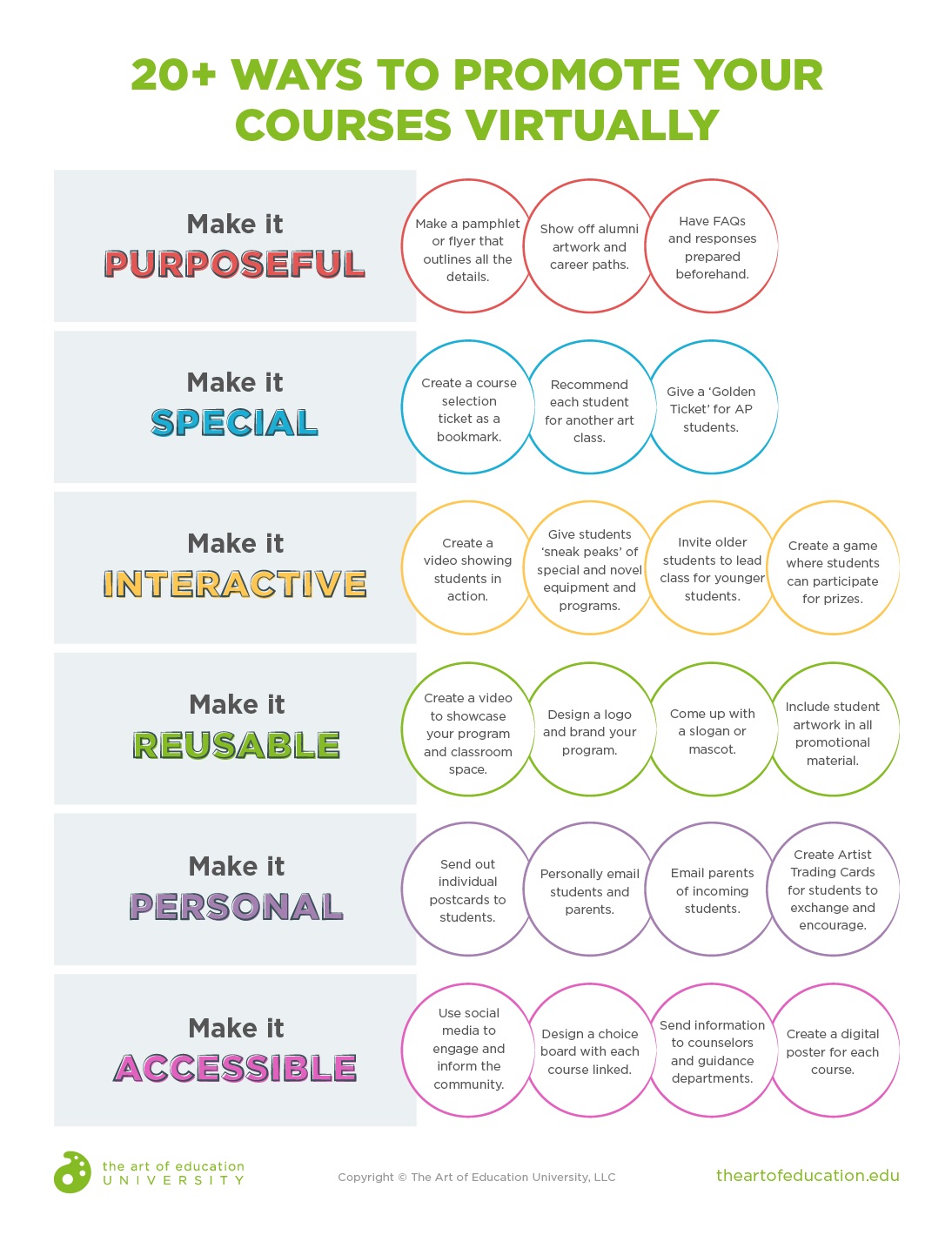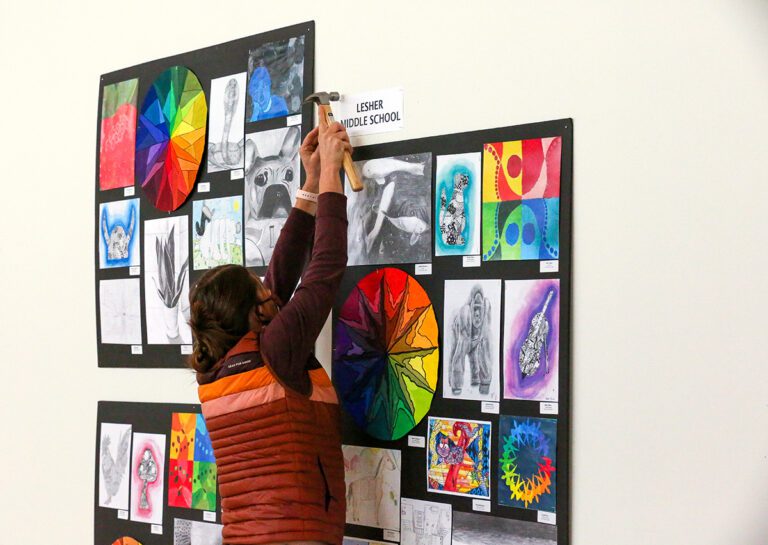The end of the semester or trimester is a great time to promote your classes. At the secondary level, promoting your visual arts courses is an essential part of the job. Unfortunately, course selection time always pops up out of nowhere just when you’re barely treading water. How can you even think about next fall when you just need to get to winter or summer break?

Even with all that added pressure, consider this an opportunity to reinvigorate and inspire another group of artists. Make promotion enjoyable, collaborative, and exciting instead of an additional burden. Collaborate with colleagues in your department, district, and community to share the responsibility. While there’s always more to do, digitally promoting this year will only add to your cache for yearly reuse.
When thinking about ways to promote your classes this year, make sure it is:
- Clear and purposeful
- Special
- Re-usable
- Interactive
- Personal
- Accessible
Make sure the path to taking visual art courses is clear and purposeful.
1. Create a pamphlet or flyer that outlines the courses being offered.
Paper pamphlets and flyers often end up in the trash. Digital resources are cheaper, more sustainable, and editable; they also reach a much wider audience. Create a clear pathway for students to determine their selection options.
- Include a brief description of each course. When teaching jewelry/metals, students need to know it’s “not just a beading class,” and when teaching darkroom photography it’s important students know they will be working with a 35mm film camera instead of their phones. While you don’t need to get into the nitty-gritty of each course, include enticing wording to excite your potential artists.
- Provide requirements or specific prerequisites. Freshmen need to know they can’t skip Drawing 1 because they are “talented” if that is something your department expects. Providing a path or outline of courses will help students and parents know how to plot their high school art career.
- Include contact information. Make sure to include your department chair or whoever will be answering the majority of questions from parents and prospective students. Include a list of art teachers’ email addresses to point a parent in the right direction.
- Send your info to counselors. Let’s face it; counselors are human, too. Sometimes they miss the nuances we provide in our courses because they manage every single course being offered at your school. Make sure they have a cheat sheet by their side and something to share with students and families to support every students’ creative needs.
- Use hyperlinks. Help students and parents learn more about each course or send an email directly by clicking on text or images.
2. Destigmatize the “starving artist” myth.
Create a slide show of alumni working in a creative field or talk about how their experience in your classes helped them in college and beyond. Help parents and students see how choosing your courses throughout high school will benefit them in the long-term. For an added fun bonus, include a piece of their high school artwork next to the work they’re creating now. Everyone will celebrate how far they’ve grown and connected their art experiences with creative career paths.
Whether students are taking the next level or trying something new, make sure they feel special.
3. Create a “ticket” that checks off which specific art classes you recommend.
Students don’t always recognize their strengths. Highlight their strengths and show students all the possibilities. Maybe a student wasn’t great at photography, but you noticed they have great drawing skills. Consider what specific teachers might be able to offer, as well. A student who needs a lot of structure will thrive with your colleague notorious for their organizational skills. Bonus: Make your course selection ticket the size of a bookmark. Students can slip it in their English text to remind them how awesome they are at art.
4. Make sure every kid in your class gets recommended for another art class.
While not every kid is ready for the next level, every student should be taking art every semester. By showing them that you have considered their strengths and interests, you are securing another student in your art program and fostering community.
5. Create a “Golden Ticket” for your Advanced Placement recommendations.
Students will feel extra special when they receive this fancy ticket. Students can bring this ticket to their course selection appointment to confirm they are eligible for the course. Even students who receive the verbal nod will often ask later for an “actual” Golden Ticket. These honors seem like such a small thing but really are a big honor to our most advanced students.
Don’t reinvent the wheel year after year! Instead, start creating a bank of resources you can use over and over.
6. Create a video you can reuse to showcase your program.
Include students talking about their favorite classes and why. Students get way more excited when they hear from their peers how awesome a course is. Including a short blurb vocalizing their genuine interest will go a long way.
7. Include student artwork in all promotional material.
Students want to see what they might create in your course. Make sure to include not only the best of the best. Students who think they “can’t draw” should see how they might start with few skills but can grow throughout the semester.
8. Show students the process, not just the end result.
Making art is hard work, but it’s also social and exciting. Photos of students working on their art while engaging in discussion, smiling and laughing, or using really cool tools like torches will remind potential artists how great it really is to take art.
9. Include frequently asked questions to help minimize questions later.
You will find the same questions pop up time and time again. Create a FAQ sheet or have students ask and answer at the end of the video.
10. Create a logo for your department and promote it with swag.
Create stickers, pins, or other items that are easily reproducible in large quantities. With many students one-to-one, they can bling out those Chromebooks and advertise your classes. Once you create a bulk order or even a template, the only thing left to do is keep a stash around for any promotional times. Bonus: Branded swag just keeps on promoting your classes FOR you!
Engage students with participatory activities.
11. Create a game where students can participate for prizes.
Make a fun trivia game, create your own virtual pottery, or some Quick, Draw. You can do this through an app or even a Google Form or quiz. This is also a great way to generate interest and gauge participation.
12. Offer a raffle to increase engagement.
Promote your courses when everyone’s a winner! A raffle gives everyone a chance to win and puts your swag to good use.
13. Hold a virtual art class.
Host a half-hour social event and have your students teach the class for you. Younger students get a chance to meet teachers and create something simple together at home, while older kids earn service hours and share their love of art.
14. Create a choice board with each course linked.
Let your students choose their own path with a choice board. Create a short video from each teacher to welcome students. Include a game to show off the cool things students will learn. Add in a simple Google Form to gather information about interest and questions.
15. Create a digital poster for each course.
Ask students to collaborate to create a design for each course. These can be turned into stickers or used in the course choice boards. Bonus: Students can earn service hours to add to their portfolio and resume!
We already know how important connection is right now. Include a personal touch in your recruitment to make students feel part of your visual art family.
16. Send out postcards.
Engage your students by having each student handwrite one to two postcards. Send these home to your incoming freshmen to invite them to take your class.
17. Create artist trading cards.
Ask your National Art Honor Society, Art Club, and advanced art students to create an original artist trading card. Scan and print multiple copies to send out to potential students. You can send them to junior high students in bulk using interdistrict mailing. Have students include their school email and create a pen pal mentorship!
18. Send personalized emails.
Sure, we all get inundated with emails. But sending an email can be as simple as “copy/paste.” Send an email directly to students (and their parents) in your classes with one personalized line. Your little encouragement will foster their love of creating.
19. Send an email to parents of incoming freshmen.
Collaborate with your junior high colleagues to identify students who would be interested in and/or excel at art. Or blast out a general info session to make sure everyone knows their options once they hit high school.
Reach as many students and families as possible this year through digital resources.
20. Social media is a great way to blast out information quickly.
Include your digital resources in emails and social media posts. Upload your videos to YouTube, add to your Instagram story, take a Twitter poll. Here are a few social media tips:
- Know your audience. Many parents are still on Facebook, while most students are not. Creating a department Facebook page can help share information to parents quickly. Older students often follow Twitter, and Instagram is pretty established for 9-12 grade students.
- Establish your brand. Ensure all email signatures or promotional materials have the handles and hashtags for parents and students to follow.
- Engage your community. Include hashtags and handles your district or other community organizations use. District communication will retweet to get out to a larger district audience and younger families.
Download the following PDF and keep it handy as you try new strategies.
Visual arts are needed more than ever. Remind students and parents that regardless of your teaching environment, the arts are essential. Advocacy now will help retain long-term enrollment and foster your visual arts community. Remember to try a few things you think will work best for your program. You don’t have to do it all this year. Consider the skillsets of teachers in your department and share the workload. Collaboration with your team will help your program grow and help connect and celebrate why you went into teaching in the first place.
How are you promoting your art classes this year?
How do you feel the pandemic will impact your enrollment next fall?
What strengths do your colleagues have to help break up the workload?
Magazine articles and podcasts are opinions of professional education contributors and do not necessarily represent the position of the Art of Education University (AOEU) or its academic offerings. Contributors use terms in the way they are most often talked about in the scope of their educational experiences.











